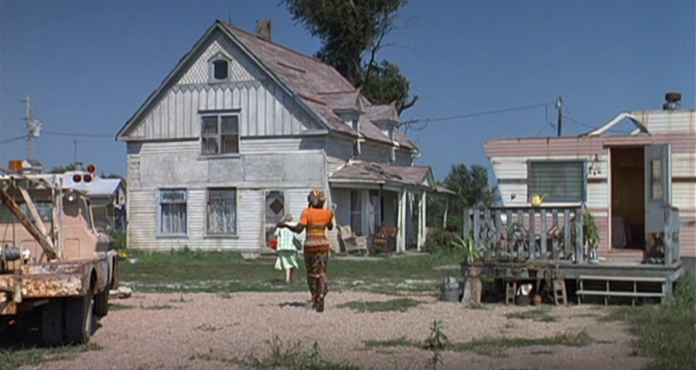Above: Still from To Wong Foo 1995
“”Snydersville” is actually Loma, Nebraska, a community of maybe thirty people about six minutes (we measure by minutes, not miles, where I’m from) from my hometown. Loma is a bar, a church, an old schoolhouse, a handful of houses, a cemetery, and… that’s really it. Honestly. Driving through the town’s strip (there’s just the one) gives a feeling of Walker Texas Ranger meets the Great Depression. While I like interacting with people back home and have genuinely enjoyed drinking Boone’s Farm and Busch Light at pasture parties near Loma, the fact is the place hasn’t changed since Tom Joad headed Californee way.
Which is why people there still talk about the time Leguizamo, Snipes, and Swayze stopped in town for their drag gig, twenty years ago. But it’s not just in people’s memory that the movie remains alive.
Several buildings, including the Catholic church, received paint jobs, new wiring, and fixed-up storefronts from the movie and most haven’t been touched up since. A building made for the movie that says “Welcome to Syndersville” still stands and is used by a family as a storage shed. And in my closet back home, as in many other people’s closets from Butler County, “Loma Goes Hollywood” t-shirts hang as relics of a bygone era.
Loma exists today as a time warp. It knows not globalization, subprime mortgages, or Bitcoin exchange rates. What it knows is hard-working folks that like their church, beer, and Husker football. To residents of fast-paced, high-density cities like New York, it’s probably shocking Clint Eastwood Western-like saloon towns like Loma still exist. Even people from Omaha can’t believe it as evidenced by this bar reviewer who got his mind rawdogged when he visited the town’s bar.”
…
“While Snipes and Swayze in drag didn’t catch my dad’s eye, I was surprised by his take on Leguizamo.
“Leguizamo looked like a woman. He was decent-looking actually.”
For my dad to admit a man was “decent-looking” and show some sort of drag-queen tolerance is like Archie Bunker coming to grips with racism and sexism. Although Dad’s comment isn’t shocking in itself, especially when you consider that Rolling Stone said Leguizamo “looks hot enough in drag to give Rosie Perez a run for parts,” it’s largely out of character for him.
Because my dad is Hank Hill. He grew up a rural farmboy who’s now nearing his mid-60s. He’s plain, straight, ordinary, blue-collar, and old-fashioned.
To be fair, my dad is no different from other men from his time and era. Growing up in Nebraska during the ’50s and ’60s, he learned to love guns, cars, and sports. There wasn’t much gay acceptance being discussed. And while he loved women, well at least my mom anyways, there wasn’t much open acknowledgment of those feelings either. Feelings and sexual orientation were assumed. Not discussed or expressed.
Which is what’s intriguing about the filming of To Wong Foo. If someone actually cross-dressed from my hometown, they’d be scorned by the community over much coffee-shop gossip. Yet To Wong Foo, a movie celebrating drag,is one of the main entries on Wikipedia if you search for my hometown area. But rather than upset people, the movie is a source of nostalgia. The only thing I can do when faced with this dissonance is smile that there exists a condition in small-town Nebraska where cross-dressing has brought joy, not to mention a little renovation.”
I watched To Wong Foo over the summer, and all this time it didn’t occur to me that the town the film is set in, Snydersville, could actually be a real town. The details of the location and set design were written off in my head as some sort of Hollywood magic that ceased to exist outside the frame. Despite the campy, high performance, cliche nature of the film, many details actually transgress into reality. The people of Loma do in many ways fit into stereotypes of what rural people look and act like, Benes uses his father as a prime example. Yet, the people of Loma aren’t ashamed to be associated with the drag and queerness of To Wong Foo. Benes’ father criticizes Swayze and Snipes’ performances, not out of hate for drag, but simply because he didn’t think they were good at being women. He also praises Legguizamo’s drag performance. These opinions align with the reactions of queer fans of the film, as well.
The queens of To Wong Foo did actually leave a positive impact on the townspeople of Loma. Although, not exactly the picture perfect Hollywood happy ending of To Wong Foo, this still proves the reversal of rural stereotypes isn’t just a film trope.
As Ohio state parks and surrounding towns develop their real estate, rural life can be pushed more and more to the fringes of society. Benes’ personal anecdotes show us that despite the imposed isolation of rural communities, rural people can still have conversations on contemporary topics that at first glance don’t align with what we expect their values and beliefs to be.
Benes, R. (2014, March 24). When John Leguizamo Fixed Up My Hometown. Esquire; Esquire. https://www.esquire.com/entertainment/movies/a28046/to-wong-foo-loma-nebraska/
Kidron, B. (Director). (1995). To Wong Foo, Thanks For Everything! Julie Newmar [Film]. Universal Pictures.




